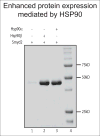Hsp90--from signal transduction to cell transformation
- PMID: 17826744
- PMCID: PMC2528838
- DOI: 10.1016/j.bbrc.2007.08.054
Hsp90--from signal transduction to cell transformation
Abstract
The molecular chaperone, Hsp90, facilitates the maturation and/or activation of over 100 'client proteins' involved in signal transduction and transcriptional regulation. Largely an enigma among the families of heat shock proteins, Hsp90 is central to processes broadly ranging from cell cycle regulation to cellular transformation. Here, we review the contemporary body of knowledge regarding the biochemical mechanisms of Hsp90 and update the most current paradigms defining its involvement in both normal and pathological cell physiology.
Figures



Similar articles
-
Mechanisms of Hsp90 regulation.Biochem J. 2016 Aug 15;473(16):2439-52. doi: 10.1042/BCJ20160005. Biochem J. 2016. PMID: 27515256 Free PMC article. Review.
-
The role of HSP90 molecular chaperones in hepatocellular carcinoma.J Cell Physiol. 2020 Dec;235(12):9110-9120. doi: 10.1002/jcp.29776. Epub 2020 May 26. J Cell Physiol. 2020. PMID: 32452023 Review.
-
The Hsp90 chaperone machinery: from structure to drug development.BMB Rep. 2009 Oct 31;42(10):623-30. doi: 10.5483/bmbrep.2009.42.10.623. BMB Rep. 2009. PMID: 19874705 Review.
-
Heat-shock protein 90, a chaperone for folding and regulation.Cell Mol Life Sci. 2002 Oct;59(10):1640-8. doi: 10.1007/pl00012491. Cell Mol Life Sci. 2002. PMID: 12475174 Free PMC article. Review.
-
HSP90 at the hub of protein homeostasis: emerging mechanistic insights.Nat Rev Mol Cell Biol. 2010 Jul;11(7):515-28. doi: 10.1038/nrm2918. Epub 2010 Jun 9. Nat Rev Mol Cell Biol. 2010. PMID: 20531426 Review.
Cited by
-
Histone H2A (H2A.X and H2A.Z) variants in molluscs: molecular characterization and potential implications for chromatin dynamics.PLoS One. 2012;7(1):e30006. doi: 10.1371/journal.pone.0030006. Epub 2012 Jan 11. PLoS One. 2012. PMID: 22253857 Free PMC article.
-
Hsp90 interaction with INrf2(Keap1) mediates stress-induced Nrf2 activation.J Biol Chem. 2010 Nov 19;285(47):36865-75. doi: 10.1074/jbc.M110.175802. Epub 2010 Sep 23. J Biol Chem. 2010. Retraction in: J Biol Chem. 2014 Apr 18;289(16):11568. doi: 10.1074/jbc.A110.175802. PMID: 20864537 Free PMC article. Retracted.
-
Contribution of the Type II Chaperonin, TRiC/CCT, to Oncogenesis.Int J Mol Sci. 2015 Nov 6;16(11):26706-20. doi: 10.3390/ijms161125975. Int J Mol Sci. 2015. PMID: 26561808 Free PMC article. Review.
-
Functional and Stress Response Analysis of Heat Shock Proteins 40 and 90 of Giant River Prawn (Macrobrachium rosenbergii) under Temperature and Pathogenic Bacterial Exposure Stimuli.Biomolecules. 2021 Jul 15;11(7):1034. doi: 10.3390/biom11071034. Biomolecules. 2021. PMID: 34356657 Free PMC article.
-
Roles of Histone Acetylation Modifiers and Other Epigenetic Regulators in Vascular Calcification.Int J Mol Sci. 2020 May 4;21(9):3246. doi: 10.3390/ijms21093246. Int J Mol Sci. 2020. PMID: 32375326 Free PMC article. Review.
References
-
- Finkelstein DB, Strausberg S. Identification and expression of a cloned yeast heat shock gene. J Biol Chem. 1983;258:1908–1913. - PubMed
-
- Meng X, Jerome V, Devin J, Baulieu EE, Catelli MG. Cloning of chicken hsp90 beta: the only vertebrate hsp90 insensitive to heat shock. Biochem Biophys Res Commun. 1993;190:630–636. - PubMed
-
- Pearl LH, Prodromou C. Structure and in vivo function of Hsp90. Curr Opin Struct Biol. 2000;10:46–51. - PubMed
-
- Pearl LH, Prodromou C. Structure and mechanism of the Hsp90 molecular chaperone machinery. Annu Rev Biochem. 2006;75:271–294. - PubMed
Publication types
MeSH terms
Substances
Grants and funding
LinkOut - more resources
Full Text Sources
Miscellaneous

